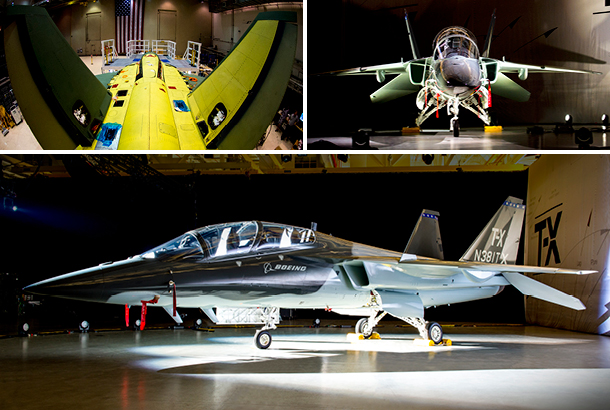
Boeing unveiled its twin-tail candidate for the Air Force's T-X competition on Sept. 13, 2016. The company also released an image of another jet that has yet to complete assembly. Boeing photos.
Boeing and its partner Saab are entering a twin-tailed, high-wing jet with an afterburning GE F404 engine in the Air Force’s T-X competition to replace the 50-plus-year-old T-38.
Revealing the aircraft at Boeing’s St. Louis, Mo., facility, Darryl Davis, head of Boeing’s Phantom Works advanced products division, said the airplane will take advantage of new manufacturing techniques—such as additive, or 3-D printing and advanced adhesives instead of fasteners in places—as well as extensive re-use of proven components to hold down costs. For example, it uses the landing gear of an F-16 fighter.
Boeing says the aircraft will take at least 10 times less hands-on maintenance than previous aircraft. It has also been designed to be highly forgiving; an airplane that is “almost impossible” for a pilot to put into a non-recoverable situation, he said.
The aircraft was designed to meet the “threshold” requirements for T-X, and if the Air Force does not give extra credit for capability beyond that, “we’re going to win,” Davis said. However, he also emphasized that the jet has growth potential for other missions. For example, it could have two hardpoints installed on each wing and it will be competitive in other trainer competitions worldwide. Whether Boeing will compete in those contests hasn’t been decided yet, as it will wait to see if it wins T-X, he said.
There is a centerline hardpoint for a cargo pod. The twin tails will best prepare pilots for the twin-tailed F-22 and F-35, and also aid stability in practicing aerial refueling, Davis explained. The cockpit is “all glass,” has a sidestick controller and a layout very similar to that of the F-35 and F-22, he said. An aerial refueling port was plumbed for the center dorsal fuselage. The twin tails also allow the airplane to be shorter, which reduces weight and cost, Davis said. The canopy is side-opening, and the types of ejection seats were not disclosed.
Boeing unveiled one completed aircraft and showed reporters another in final assembly. Davis noted that the aircraft does not make use of large-scale composites and is being built “with no tooling.”
A Saab official confirmed that the aft end of the aircraft—from the cockpit back—was built in Linkoping, Sweden, and although neither company would discuss workshare, Davis allowed that a widely-circulated internet image of a “wrapped” fuselage shipped from Sweden to St. Louis had “no wings, no verticals, and no horizontal” surfaces.
Although Boeing will perform much of the engineering, manufacturing, and development activities for its T-X trainer candidate at its St. Louis facilities—and both EMD examples will have undergone final assembly there—no decision has been made about where final assembly will take place if Boeing wins the T-X production contract, according to Boeing officials.
There is an “equitable workshare,” Davis said, adding that in potential world marketing, the team would make use of Saab’s “large footprint” having sold the Gripen fighter on four continents. He described the T-X jets as “production representative,” and akin to an “EMD,” or engineering and manufacturing development-class aircraft, that are ready for Air Force evaluation, having been through preliminary and critical design reviews.
Davis said the extensive modeling and simulation will make it possible to streamline testing, saving money, but he declined to comment on how this approach will differ from that taken on the F-35, which suffered large delays to over-reliance on modeling and simulation in lieu of flight testing.
Advancements in manufacturing will allow the Boeing T-X to be built “faster than ever before,” Davis asserted. Though he would not say precisely when first flight will occur, he said it will happen “before the end of the year.” That is about when the final USAF request for proposals is due.



